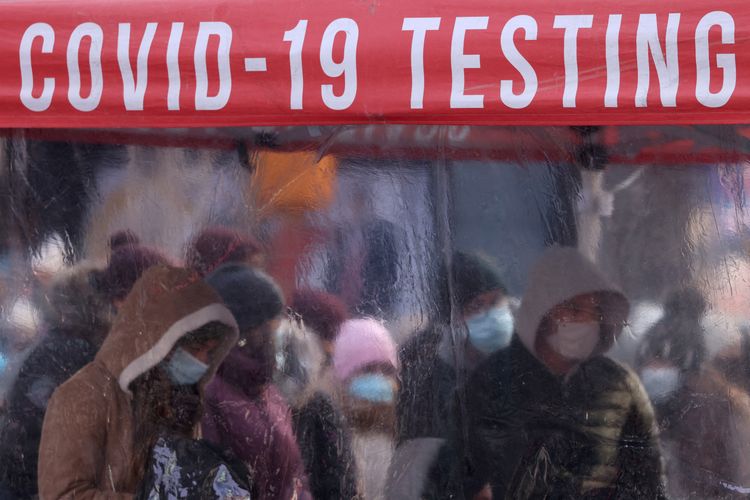By Maria Caspani
New coronavirus cases are falling in parts of the United States hardest hit by the fast-spreading Omicron variant, according to a Reuters analysis of public health data, offering an early indication the virus might once again be on retreat.
COVID-19 infections have decreased in 15 states plus Washington, D.C. and Puerto Rico, an analysis of the past week through Wednesday compared with the prior week showed.
In the Northeast, which saw some of the highest case loads during the latest surge, infections are down 36% week-over-week.
The drop was more modest at the national level, with the seven-day average of new COVID-19 cases falling 1% as of Wednesday, according to the Reuters tally.
COVID-19 data often lag a few days behind the actual state of affairs.
“Certainly it bodes well for us in terms of the trajectory of Omicron,” said Wafaa El-Sadr, a professor of epidemiology and medicine at Columbia University in New York City.
While falling case numbers in parts of the country that were first and hard-hit by the variant offer tangible hope of turning a corner, infections are still on the rise across swathes of the United States.
Cases are still climbing in the Midwest, which has the highest week-over-week increase at 14%, followed by the South at 8% and Western states at 7%, although the increase has slowed considerably in recent weeks.
Nationally, cases are averaging a still high 765,000 a day, down from a peak of 805,000 on Jan. 15. Deaths, which usually lag about three weeks behind cases, are averaging 1,950 a day, up from 1,300 at the start of the month but well below the 3,300 lives lost a day during the surge in January 2021.
COVID hospitalizations, also a lagging indicator, hit a record high on Wednesday of 152,555, according to the Reuters tally, but have been showing signs of stabilizing around the 150,000 mark over the past week.
“We have to be cognizant that we’re not out of the woods, that there’s a glimmer of hope, there is light at the end of the tunnel,” El-Sadr said. “That light is closer or further away based on who you are and where you happen to be.”
Many hospital systems across the country are still struggling to cope with the Omicron-led surge. Last week, the administration of President Joe Biden said it was sending military health workers to hospitals in six U.S. states to help fight the deluge of cases and staff shortages.
The federal government also recently began providing Americans with free at-home tests and will soon make millions of N95 masks available after Biden incurred criticism he was not devoting enough efforts to fight the pandemic.
The rapid spread of Omicron over the winter holidays forced Americans to pull the brake on plans for a gradual return to normality as the United States entered its third pandemic year.
Classes were canceled or delayed in some school districts, the ranks of teachers and staff decimated by illness and safety requirements. Exhausted parents were left to navigate a patchwork of school COVID-19 policies while some students, feeling unsafe in school buildings, staged walkouts demanding a switch to remote learning.
Businesses changed or postponed their back-to-office plans, while the sweeping surge forced entertainment venues to temporarily shut down.
However, the recent drop in cases in states like New York, New Jersey and Rhode Island is not the only cause for optimism.
El-Sadr, the epidemiology professor, pointed to positive developments in the current fight against the pandemic, including that Omicron has proven to be milder compared to other strains of COVID-19, the great protection of vaccines against severe illness and the potential for mRNA vaccines to be adapted quickly to new variants.
(Reporting by Maria Caspani; Editing by Lisa Shumaker)
For more coronavirus coverage, visit longislandpress.com/coronavirus.
Sign up for Long Island Press’ email newsletters here. Sign up for home delivery of Long Island Press here. Sign up for discounts by becoming a Long Island Press community partner here.






























